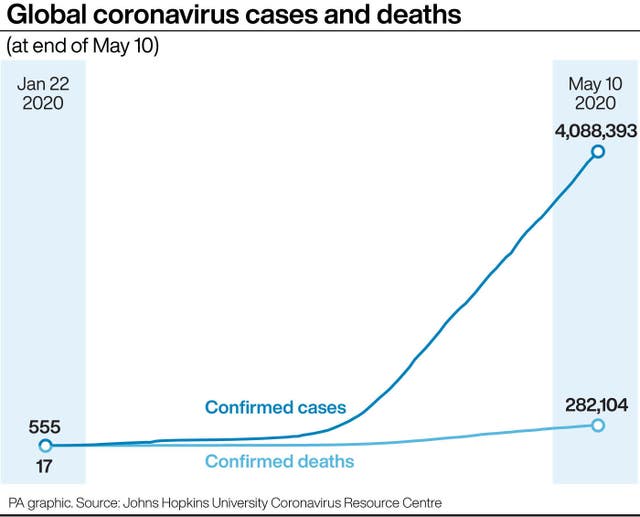
Plastic barriers and face masks appeared on the streets of Europe’s newly reopened cities, as France and Belgium emerged from lockdowns, the Netherlands sent children back to school and Greece and Spain further eased restrictions.
All faced a delicate balance of trying to restart battered economies without fuelling a second wave of coronavirus infections.
Social distancing was the order of the day but just how to do that on public transport and in schools was the big question.
With Monday’s partial reopening, the French did not have to carry forms allowing them to leave their homes but crowds quickly developed at some metro stations in Paris, one of France’s viral hotspots.
READ MORE: Coronavirus in Scotland: New legislation aims to help struggling Scots
 School principal Antoinette van Zalinge dressed up to show pupils the need of social distancing (Peter Dejong/AP)
School principal Antoinette van Zalinge dressed up to show pupils the need of social distancing (Peter Dejong/AP)
A last-minute legal challenge emerged to the government’s practice of confining people to their own regions, further confusing the post-lockdown landscape.
Antoinette van Zalinge, principal of the De Notenkraker elementary school in Amsterdam, wore a wide white skirt and a hula hoop slung from her shoulders and carried a long stick with a hand at one end so she could shake hands with students while still keeping 1.5 metres (5ft) apart.
In Paris, hairdressers practised their new workflow over the weekend ahead of Monday’s reopening, and planned to charge a “participation fee” for the new disposable protective gear they will need for each customer.
Walk-in customers will be a thing of the past, said Brigitte L’Hoste, manager of the Hair de Beaute salon, who expects the number of appointments to be cut in half.
“The face of beauty will change, meaning clients won’t come here to relax. Clients will come because they need to,” said Aurelie Bollini, a beautician at the salon.
“They will come and aim at getting the maximum done in the shortest time possible.”
 A waitress carries a tray across the road to a terrace bar in Seville, Spain (Miguel Morenatti/AP)
A waitress carries a tray across the road to a terrace bar in Seville, Spain (Miguel Morenatti/AP)
Roughly half of Spain’s 47 million people stepped into a softer version of the country’s strict confinement, beginning to socialise, shop in small stores and enjoy outdoor seating in restaurants and bars.
Its biggest cities of Madrid and Barcelona remained under lockdown, however.
Fears about new waves of infection have been born out in Germany, where a new cluster was linked to a slaughterhouse; in Wuhan, the Chinese city where the virus started; and in South Korea, where a single nightclub customer was linked to 85 new infections.
The South Korean government pushed back hard against that wave, halting the school reopenings that had been planned for this week and reimposing restrictions on nightclubs and bars.
It is now trying to track 5,500 people who had visited a popular Seoul entertainment district by checking credit card transactions, mobile phone records and security camera footage.
In Germany, gyms reopened in the most populous state, but authorities there and in France have said any backsliding in the daily number of infections could lead to new restrictions.
READ MORE: Tories demand to see Sturgeon's evidence for 'slower approach' to lockdown
“We’re going to have to learn to live with the virus,” health minister Olivier Veran said.
The hurdles ahead for tourism and the service industries were clear, even in places where infections are diminished.
Shanghai Disneyland reopened to visitors, but let in limited numbers and demanded that they wear face masks and have their temperatures checked.
“We hope that today’s reopening serves as a beacon of light across the globe, providing hope and inspiration to everyone,” Shanghai Disney Resort president Joe Schott told reporters.
In the US, Trump administration officials spoke optimistically about a relatively quick rebound from the pandemic – but then had to announce that vice president Mike Pence was self-isolating after one of his aides tested positive.
US treasury secretary Steven Mnuchin predicted the American economy would rebound in the second half of this year from unemployment rates that rival the Great Depression.
Another 3.2 million US workers applied for jobless benefits last week, bringing the total over seven weeks to 33.5 million unemployed.
The US has seen 1.3 million infections and nearly 80,000 deaths, the most in the world by far, according to a tally by Johns Hopkins University.
Worldwide, four million people have been reported infected and more than 280,000 have died, over 150,000 of them in Europe.
 (PA Graphics)
(PA Graphics)
Health experts believe all those numbers understate the true toll of the pandemic for different reasons.
India reported its biggest daily increase in coronavirus cases as it prepared to resume train services to ease a lockdown that has hit migrant workers especially hard by eliminating the daily wages they use to feed their families.
The government reported 4,213 new cases for a total of more than 67,000, including 2,206 deaths.
The railway system is India’s lifeline, transporting 23 million people across the vast subcontinent each day.
 Migrant workers from other states desperate to return to their homes gather near a train station in Ahmedabad, India (Ajit Solanki/AP)
Migrant workers from other states desperate to return to their homes gather near a train station in Ahmedabad, India (Ajit Solanki/AP)
When service restarts on Tuesday, passengers must wear masks and pass health screenings before being allowed to board and the trains will make fewer stops than usual.
While unemployed workers in developed nations are temporarily buoyed by benefits and job protection schemes, millions elsewhere are facing dire economic prospects.



Why are you making commenting on The Herald only available to subscribers?
It should have been a safe space for informed debate, somewhere for readers to discuss issues around the biggest stories of the day, but all too often the below the line comments on most websites have become bogged down by off-topic discussions and abuse.
heraldscotland.com is tackling this problem by allowing only subscribers to comment.
We are doing this to improve the experience for our loyal readers and we believe it will reduce the ability of trolls and troublemakers, who occasionally find their way onto our site, to abuse our journalists and readers. We also hope it will help the comments section fulfil its promise as a part of Scotland's conversation with itself.
We are lucky at The Herald. We are read by an informed, educated readership who can add their knowledge and insights to our stories.
That is invaluable.
We are making the subscriber-only change to support our valued readers, who tell us they don't want the site cluttered up with irrelevant comments, untruths and abuse.
In the past, the journalist’s job was to collect and distribute information to the audience. Technology means that readers can shape a discussion. We look forward to hearing from you on heraldscotland.com
Comments & Moderation
Readers’ comments: You are personally liable for the content of any comments you upload to this website, so please act responsibly. We do not pre-moderate or monitor readers’ comments appearing on our websites, but we do post-moderate in response to complaints we receive or otherwise when a potential problem comes to our attention. You can make a complaint by using the ‘report this post’ link . We may then apply our discretion under the user terms to amend or delete comments.
Post moderation is undertaken full-time 9am-6pm on weekdays, and on a part-time basis outwith those hours.
Read the rules hereLast Updated:
Report this comment Cancel